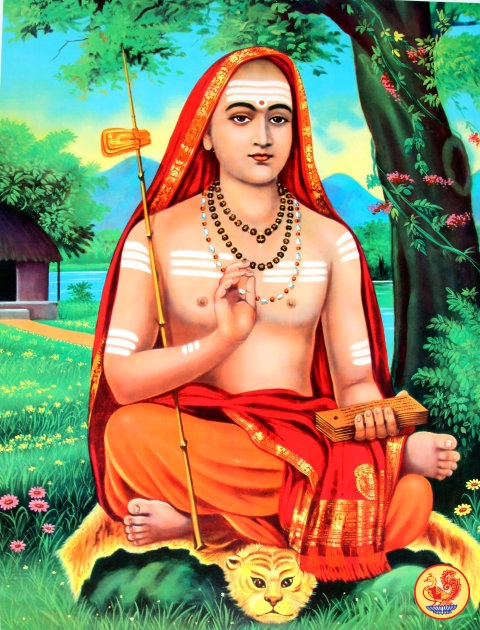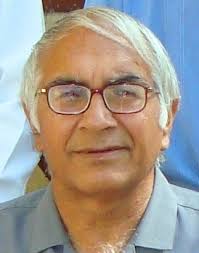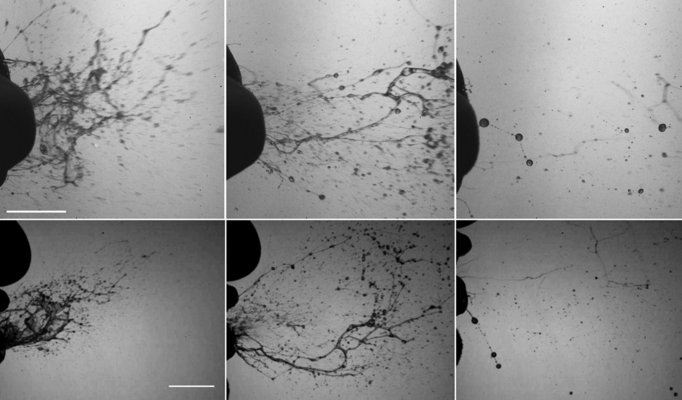
- Dr Satish K Kapoor
As a sage, scholar, philosopher, poet, dialectician, religious reformer, and an exegete of sacred texts, Adi Shankara stands out among the greatest figures in the history of religion. A foremost exponent and pious propagator of the Advaita Vedanta, absolute monism, to which he gave a unique and methodical interpretation based on discursive reason, he deflated the atheistic, agnostic, nihilist, dualist, materialist and such other schools of philosophy of his time as were inconsistent with the quintessential of the Vedic wisdom that speaks of oneness of the Self. He subordinated faith to reason, intuition to intellect, pravritti karma, actions that entangle one in the world to nivritti karma, actions that emancipate,formal worship to meditation of the Self, and sensory pleasures to the life of the spirit.He tried to restore the Vedic faith to its pristine purity; internally by removing accretions that had covered it, and externally, by defeating opponents, through open debates and writings.
The date of Adi Shankara has been a matter of controversy, ranging between 5th century BCE to 8thcentury CE. However, it is commonly believed that he lived between 788-820 CE. According to traditional accounts, he was born to Nambudari brahmin parents – Shivaguru and Aryamba – in Kaladi, a village located east of Periyar river in the Ernakulam district of Kerala.Adi Shankara was a prodigy who learnt the Vedas and Vedangas, ‘limbs of Vedas’, at an early age. He took sannyasa , vow of renunciation,when he was about eight and a half years old, after the death of his father. For this act he received the blessings of his recalcitrant mother, who acquiesced to his monastic propensity after a miraculous incident that had saved his life from the jaws of a crocodile. After leaving Kerala, he got formal initiation (diksha) from Govinda Bhagavatapada who lived on the banks of river Narmada. Govinda was a disciple of Gaudapadacarya, author of the famous Karika – philosophical verses – on the Mandukya Upanishad belonging to the Atharva Veda. As per tradition, he met his Guru’s guru at Badarikashrama (Uttarakhand),and after having imbibed the nuances of Brahma vidya, divine knowledge, left for Kashi (Banaras, Uttar Pradesh), the intellectual capital of Bharatavarsha at that time, where he wrote his commentaries on the Brahma Sutras, and other sacred texts. He visited Badrikashrama again and continued to systematize his ideas on the non-dualistic aspect of Vedanta.
In Adi Shankara’s time, the Vedic teachings had been reduced to the performance of sacrificial ceremonies(karma kanda), by mimamsakas like Kumarila Bhatta and Mandana Mishra, which the poor could not afford. Rituals were projected as the elan vital of dharma to attain worldly gains and heavenly bliss. Heterodox sects preached abstruse philosophical doctrines,or promoted populist forms of worship, without spiritual purport. Kapalikas, Vama Margis, Shaktas and others indulged in unethical or irrational practices like human or animal slaughter (bali). The common man was caught between the Scylla of religious skepticism, characterized by the denial of god, and the Charybdis of blind faith, between worship of one god and the adoration of many deities, between belief in the centrality of consciousness and the primacy of matter,between philosophy of the void and the reality of the world, and between chosing Hindu mythology and icons, and mythopeic heritage of Buddhists, Jainas and others.
To dispel this confusion, Adi Shankara launched a crusade on three fronts – against the orthodoxy misrepresenting the message of the Vedic rishis;against the turbulent currents of heterodoxy eroding the Vedic ethos; and against nefarious cults which were masquerading as genuine faiths.On the positive side, he made the Vedic Sanatana Dharma coherent and resolved scriptural paradoxes so that it could carry multitudes He tried to reconcile, harmonize and absorb the seemingly contradictory religious viewpoints in the all-embracing fold of Advaita Vedanta. Thereby, he established the infallibility of his doctrine, which had descended in its nascent form – from Yajnavalkya and Uddalaka Aruni of the Upanishads, to sage Badarayana,Gaudapada, and Govinda Bhagvadpada, in peerless rivulets,and turned it into a mighty stream with his passion for establishing the ultimate truth.
During the course of his travels through the length and breadth of India,Adi Shankara deflated prevalent ideologies with his uncanny brilliance, command of Sanskrit and the skill to mould and interpret scriptural words figuratively. A great debater like Saint Augustine (354-430 CE) he challenged dogmas, non-Vedic or pseudo-Vedic beliefs. He reproached the nastika – non-believer – schools like Jainism and Buddhism who denied god and the revealed authority of the Vedas; Ajivikas who believed in absolute determinism; madhyamikas who felt that liberation lies in the theology of emptiness; samkhyas who espoused dualism between consciousness and matter, and rejected the concept of one All-pervading entity; Nyaya-Vaisheshika scholars for their theory of atomism; mimamsakas who ridiculed monasticism and overemphasized rituals; lokayatas who regarded the world itself as the basis of reality and denied spiritual aspects; left-hand tantrics who employed ‘five Ms’ – panchamakara – namely wine (madya), fish (matsya), meat (mamsa), posture (mudra) and copulation(maithuna), in their religious practices; and so on.
While Justine Martyr (d.c.165CE) justified the precepts of Christianity by alluding to the Greek philosophy, Adi Shankara justified Advaita Vedanta by referring to the three basic texts of the Vedanta philosophy (prasthanatrayi),namely, the Upanishads, Brahmasutra and the Bhagavadgita. He did for the refinement of the intellect what the Buddha had done for the refinement of the heart. He thus paved way for the religion of reason, and provided a weltanschauung that could satiate rational and scientific minds. Having been familiar with the logical realism of Nyaya, the atomic pluralism of Vaisheshika the evolutionism of Samkhya, the psychology of Yoga, the ritualistic philosophy of Purva Mimamsa, and the Vedanta doctrine in its various aspects, Adi Shankara argued that none other than Advaita Vedanta could fulfil man’s eternal quest for the supreme reality since it was the logical culmination and fulfilment of all the six schools of philosophy (shad darshana). He accepted perception, inference and scriptural testimony as the sources of true knowledge. Through reasoning which bespeaks of his religio-mathematical genius, he established that the plurality of spatio- temporal world was an illusion (maya) veiling the one Supreme Reality. This he linked to the speculations of the Upanishadic sages about the Supreme Self,aiming at elevating individual consciousness to the level of cosmic consciousness (Brahman), recognizing at the same time,three planes of existence – absolute, paramarthika satta, worldly, vyavaharika satta, and illusory, pratibhashika satta. Adi Shankara was sometime addressed by his critics as ‘a Buddhist in disguise’ (Prachchhanna Baudha) because of his views on brahman and maya which bore verisimilitude to the concepts of void (shunyata) and liberation (nirvana) in Mahayana Buddhism.
Adi Shankara ascended the seat of learning, called sarvajna pitha, ‘all-knowing throne’, in Kashmir, after humbling great religious minds of his time like the Kanya Kubja brahmin Mandana Mishra of Tara Pitha, Mahishmati (identified with a town in north Bihar or with Maheshwar near Ujjain), who was exponent of Karma-mimamsa school; Navagupta, a tantric of Kamarupa (Assam); Bhatta Bhaskara, a scholar of Bhedabheda– ‘identity and difference’-school in Ujjayini (Madhya Pradesh); Nilkantha, a Saiva theologian of Gokarna (Karnataka); Abhinava Gupta, author of Tantraloka (‘world of Tantra’) and other scholarly writings central to Kashmir Saivism; Bana, Mayura and Dandin of Avanti (in present Madhya Pradesh)and many others. Some of his opponents were converted to his view point or became renunciates along with their followers, as in case of Mandana Mishra and his spouse, Bharati.
Adi Shankara extolled the virtues of truth, wisdom justice, temperament and courage, believing that all these and more stem from an enlightened intellect, not vice versa. To him self realization did not mean a theoretical knowledge of the Absolute – the knower of Brahman becomes verily Brahman (brahmavit brahmaiva bhavati).He made his logical concepts functional so that these could manifest in moral and humanist pursuits. But he believed that the observance of moral codes was not the end but the means to attain true knowledge of the Self.
The prerequisite for a spiritual aspirant include guidance of a genuine guru and the observance of four types of practices(sadhana chatushtaya) namely, viveka, discrimination, vairagya, non-attachment, shata sampata, six virtues–tranquility, training, withdrawal, forbearance, faith and focus–and mumukshatava, passion for enlightenment. Adi Shankara recommended the traditional path of righteous listening (shravana), righteous reflection (manana), and righteous meditation of the soul (nididhyasana) to understand, recognize and to realize the ultimate truth. He held that sacrifice (yajna), austerity (tapah) and charity (dana) make one fit (adhikari) to acquire the knowledge of Brahman, who is Existence-Knowledge-Bliss(sat-cit-ananda).Brahman being infinite (ananta) and all-pervasive (vibhu) is the substratum (adhishthana) and the illuminator (prakashaka) of the illusory nature of creation (maya), yet it is unattached to and unaffected by phenomena which has empirical reality. Due to maya the individual soul (jiva), identifies with body, mind and the senses, and considersitself separate from Brahman. Self knowledge (brahma jnana) leads to self realization(brahma anubhava) which is tantamount to liberation (moksha), not after death as in other traditions, but in present life. The liberated soul (jivanamukta) learns the art of dying while living.
The knowledge of Brahman, imparted through the method of superimposition (adhyaropa) and subsequent negation (apavada), dispels deep-seated ignorance (avidya)which is the cause of error and hence bondage. Due to nescience,one perceives diversity where there is unity. Adi Sankara emphasized that the self alone illumines body, mind and the senses and the world of phenomena. Knowing the Self is knowing everything; becoming the self is becoming everything. The Self is unconditioned by space, time and causation. The knowledge (vidya) of Brahman, spurs one to the knowledge of Brahmanda, cosmos; the microcosmic drop becomes the macrocosmic ocean. The physical and the metaphysical, the material and the spiritual, are then perceived as dimensions of the One Reality. Identification of Brahman with the empirical self endows the human soul with supreme beauty, human mind with supreme intelligence, and the human body with the supernal feeling that it has descended from the supreme source. Adi Sankara thus raised human being to lofty, divine heights.
Some great sayings (mahavakya) which elucidate the Advaita Vedanta of Adi Shankara are: prajnanam brahma -‘consciousness is Brahma’ (Aitareya Upanisad, 3.3); aham brahmasmi -‘I am Brahma’ (Brhadaranyaka Upanisad, 1.4.10); soham asmi–’ I am He’ (Ishavasya Upanisad, verse 16);tat tvamasi‘ Thou art that'(Chhandogya Upanisad, 6.8.7); ayamatma brahma ‘This atman is Brahma (Brihdaranayaka Upanishad,1.4.10); ekam eva dvitiyam brahma –’Brahma is one without a second’ (Chandogya Upanishad, 6.2.1); sarvaam khalu idam brahma– ‘All this is Brahma’ (Chandogya Upanisad,3.14.1); brahma satyam jagat mithya, jivo brahmaiva naparah , ‘Brahma is the only truth, the world is unreal, and there is ultimately no difference between Brahma and the individual self’ (Viveka cudamani), and so on.
To keep alive the Vedic Sanatana Dharma and to organize the ancient order of monks, as done earlier by the Buddha (6th century BCE) in India and the Christian saint Benedict (480-542 CE), in the west, Adi Shankara established ten monastic orders (dashnami sampradaya) of ekadandi, ‘single-staff’ renunciants, namely, Aranya, Vana, Giri, Parvata, Sagara, Tirtha, Asrama, Bharati, Puri and Sarasvati, and four pithas, monasteries, in four directions of the country to carry forward his mission -Jyotirmatha,Uttarakhand, in the north,under the charge of Totakacharya; Govardhana matha, Puri, Odisha in the east, under the charge of Padmapada; Kalika matha, Dwarka in the west, under the charge of Hastamalaka; and Shringeri Sharadapitha, Karnataka, in south-west, under the charge of Sureshwara, besides the Kanchi Kamakoti Peetam, Kanchipuram, Tamil Nadu ( established as per tradition in 482 B.C.E.) Each pitha was to be governed by strict monastic discipline,keep away from meaningless rites, promote Sanskrit and scriptural studies, and carry forward the revealed (jnapaka) message of the Vedas. The pithas have become centres of pilgrimage and are held in great reverence. In order to unite various sects of Sanatana dharma he introduced the Panchayatana form of worship, the simultaneous adoration of five deities–Shiva, Vishnu, Devi or Shakti in her various forms, Ganesa and Surya – placing one’s chosen deity (ishtadevata), in the centre, and considering them all as symbolic of brahman with attributes (saguna). He is also said to have started the Shanmata tradition, the ‘six-fold path’ of Smarta brahmins, in which the name of Kumara (Kartikeya), son of Shiva, is added to the pantheon of five principle deities, and composed devotional verses for each.
Just as Origen (182-254 CE), an early Christian theologian, explicated the Old Testament texts, Adi Shankara wrote authoritative commentaries on the prasthanatrayi and other works. A number of philosophical treatises on Advaita, called Prakarana granthas have been attributed to him like,Viveka cudamani, ‘crest-jewel of discrimination’, Atmabodha,‘soul realization’, Prabodha–sudhakara, ‘Nectarine mine of wakefulness’, Aparokshanubhuti, ‘direct experience’, Upadesha Sahasri, ‘A thousand teachings’,Prashnottara Ratna Malika, ‘Gem-garland of questions and answers’, Sadhana Panchakam, ‘Five verses on spiritual practice’ , Tattva bodha, ‘Knowledge of the Truth’, Nirguna Manasa Puja, ‘Worship of the attributeless spirit’, Vijnana-nauka-‘boat of knowledge’, and many other works having one, five, seven, ten or more verses.Besides, he made soulful compositions (stotras) like Saundraya Lahari, Dakshinamurti Stotra, Dashavatara Stotra Kanakadhara Stotra, Bhujanga Stotras and Bhaja Govindam, which reveal his poetic-mystic nature, and remain popular with scholars and common people.
Adi Shankara’s philosophy is not negative, escapist, or other-worldly but experimental and experiential. It is dynamic in the sense that the world is not regarded as illusory but as the modification (vivarta) of Brahman, just like the tricks of a magician who can obscure but not change the reality. This is vivartavada, in which the world is relatively real, unlike the future speculation of Ramanuja (1017-1137 CE) who put forth the theory of transformation ( parinamavada), like milk becoming curd.
Although Adi Shankara argued that knowledge (jnana) alone can lead to liberation ( brahma vidya moksa sadhanam) ; and that action (karma) and jnana cannot join together (nasty sangatyam), he differentiated between the ultimate (paramarthika) and the conventional ((vyavaharika) dimensions of both. He revolutionized the Indian philosophy by his interpretation of Advaita Vedanta which can accommodate all shades of opinion and schools of thought, and by bringing about a synthesis of the empirical and the metaphysical aspects of life. His quest for knowledge was born of devotion (bhakti) to the one impersonal being ; his vow of sannyasa, did not deter him from leading an active life, like a karma yogi.
Adi Shankara appealed to the scholar and the common man alike by offering the doctrine of strict monism to the former, and the idea of Ishwar – the creative and expressive aspect of Brahman – to the latter.By proclaiming the principle of sarvatmabhava , feeling of oneness in all souls, and its corollaries, oneness of existence, unity of mankind, and salvation for all, he became a precursor to the Bhakti movement of medieval India,. He paved the way for devotional path with jnana as its substratum, as per the Vedic Sanatana tradition of spirituality, and laid emphasis on detached action.
Adi Shankara left his mortal coil at Kedaranath (Uttarakhand) in the Himalayas, when he was 32 years of age, but Advaita Vedanta lives due to its logical and universal basis, and a healthy world view, despite several critiques, from his contemporaries to Ramanuja, Madhava (1238-1317) , Nimbarka (13th century) and others, down to modern religious and philosophical thinkers.

Dr Satish K Kapoor, a former British Council Scholar, was Principal, Lyallpur Khalsa College, and Registrar DAV University, Jalandhar. He has authored 7 books, written about 400 articles, essays, book reviews and research papers, and contributed to Encyclopedia of Sikhism and Encyclopedia of Hinduism( of which he was Associate Subject Editor). His latest work is, Hinduism, The Faith Eternal (Advaita Ashrama, Kolkata).


 South Asian News E-Paper
South Asian News E-Paper Punjabi News E-Paper
Punjabi News E-Paper

















